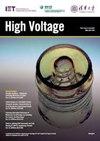Investigating New Approaches for Optimal Energisations of DC Cables: The Stepwise Energisation Technique
IF 4.9
2区 工程技术
Q1 ENGINEERING, ELECTRICAL & ELECTRONIC
引用次数: 0
Abstract
This paper focuses on the energisation of high voltage DC (HVDC) and medium voltage DC (MVDC) insulation systems, referring mainly to cables for both theoretical development and validation testing. Cable system energisation can be frequent during its lifetime, and it can possibly be affected by partial discharges (PD), because of manufacturing, laying, ageing, interfaces or structural cavities (as butt gaps). A theory-driven and measurement-based procedure is presented in this paper, having the purpose to minimise PD inception risk. This procedure is based on stepwise voltage application during cable energisation. The fundamental idea behind the proposed approach stems from considering that the jump voltage is the trigger of PD occurrence. Indeed, the jump voltage, and the consequent electric field variation, directly relates to AC PD inception voltage (PDIVAC). In addition, the electric field distribution in an insulation system is driven by insulation permittivity (capacitance) during voltage transients, and by conductivity in DC, thus the PDIVAC is generally smaller than DC PD inception voltage (PDIVDC). Hence, energising a DC cable by an initial step lower than PDIVAC, and then increasing the voltage in steps smaller than PDIVAC, would minimise the risk of PD inception during transients and the relevant degradation rate. However, this does not change, the risk of occurrence (if any) of low-repetition partial discharges at DC steady state. Effectiveness of the proposed technique is proved by the help of tests performed on cables with artificial surface and internal defects. It is shown that compared with the conventional energisation consisting of rapidly increasing voltage, the stepwise approach can reduce the risk of PD inception and related extrinsic ageing, even for the steady state voltages larger than PDIVDC.研究直流电缆优化激励的新方法:逐步激励技术
本文主要研究高压直流(HVDC)和中压直流(MVDC)绝缘系统的激励问题,主要涉及电缆的理论发展和验证测试。电缆系统在其使用寿命期间可能会频繁通电,并且可能受到局部放电(PD)的影响,原因包括制造、铺设、老化、接口或结构空腔(如对接间隙)。本文提出了一个理论驱动和基于测量的程序,目的是最大限度地降低PD开始风险。这个程序是基于电缆通电过程中逐步施加的电压。提出的方法背后的基本思想源于考虑跳跃电压是PD发生的触发因素。事实上,跳变电压以及随之产生的电场变化与交流放电起始电压(PDIVAC)直接相关。此外,绝缘系统中的电场分布由电压瞬态时的绝缘介电常数(电容)和直流时的电导率驱动,因此PDIVAC通常小于直流PD起始电压(PDIVDC)。因此,以低于PDIVAC的初始步长给直流电缆通电,然后以小于PDIVAC的步长增加电压,可以最大限度地降低瞬变过程中PD发生的风险和相关的降解率。然而,在直流稳态下发生低重复部分放电的风险(如果有的话)并没有改变。通过对具有人工表面缺陷和内部缺陷的电缆进行试验,验证了该方法的有效性。结果表明,即使稳态电压大于PDIVDC,与传统的快速增加电压的激励方法相比,逐步激励方法也可以降低PD发生的风险和相关的外在老化。
本文章由计算机程序翻译,如有差异,请以英文原文为准。
求助全文
约1分钟内获得全文
求助全文
来源期刊

High Voltage
Energy-Energy Engineering and Power Technology
CiteScore
9.60
自引率
27.30%
发文量
97
审稿时长
21 weeks
期刊介绍:
High Voltage aims to attract original research papers and review articles. The scope covers high-voltage power engineering and high voltage applications, including experimental, computational (including simulation and modelling) and theoretical studies, which include:
Electrical Insulation
● Outdoor, indoor, solid, liquid and gas insulation
● Transient voltages and overvoltage protection
● Nano-dielectrics and new insulation materials
● Condition monitoring and maintenance
Discharge and plasmas, pulsed power
● Electrical discharge, plasma generation and applications
● Interactions of plasma with surfaces
● Pulsed power science and technology
High-field effects
● Computation, measurements of Intensive Electromagnetic Field
● Electromagnetic compatibility
● Biomedical effects
● Environmental effects and protection
High Voltage Engineering
● Design problems, testing and measuring techniques
● Equipment development and asset management
● Smart Grid, live line working
● AC/DC power electronics
● UHV power transmission
Special Issues. Call for papers:
Interface Charging Phenomena for Dielectric Materials - https://digital-library.theiet.org/files/HVE_CFP_ICP.pdf
Emerging Materials For High Voltage Applications - https://digital-library.theiet.org/files/HVE_CFP_EMHVA.pdf
 求助内容:
求助内容: 应助结果提醒方式:
应助结果提醒方式:


